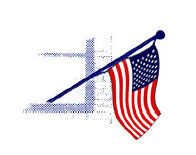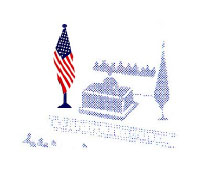|
Guidelines for Display of the Flag
Public Law 94-344, known as the Federal Flag Code, contains rules for handling and displaying the U.S. flag. While the federal code contains no penalties for misusing the flag, states have their own flag codes and may impose penalties. The language of the federal code makes clear that the flag is a living symbol.
In response to a Supreme Court decision which held that a state law prohibiting flag burning was unconstitutional, Congress enacted the Flag Protection Act in 1989. It provides that anyone who knowingly desecrates the flag may be fined and/or imprisoned for up to one year. However, this law was challenged by the Supreme Court in a 1990 decision that the Flag Protection Act violates the First Amendment free speech protections.
Important Things to Remember
Traditional guidelines call for displaying the flag in public only from sunrise to sunset. However, the flag may be displayed at all times if it’s illuminated during darkness. The flag should not be subject to weather damage, so it should not be displayed during rain, snow and wind storms unless it is an all-weather flag.
It should be displayed often, but especially on national and state holidays and special occasions.
The flag should be displayed on or near the main building of public institutions, schools during school days, and polling places on election days. It should be hoisted briskly and lowered ceremoniously.
 |
The U.S. flag, when carried in a procession with another or other flags, should be either on the marching right (the flag’s own right) or, if there is a line of other flags, in front of the center of that line. Never display the U.S. flag from a float except from a staff, or so suspended that its folds fall free as though staffed.
|
 |
The U.S. flag, when displayed with another flag against a wall from crossed staffs, should be on the U.S. flag’s own right, and its staff should be in front of the staff of the other flag.
|
 |
The U.S. flag should be at the center and at the highest point of the group when a number of flags of states or localities or pennants of societies are grouped and displayed from staffs. |
 |
When the U.S. flag is displayed other than from a staff, it should be displayed flat, or so suspended that its folds fall free. When displayed over a street, place the union so it faces north or east, depending upon the direction of the street. |
 |
When other flags are flown from the same halyard, the U.S. flag should always be at the peak. When other flags are flown from adjacent staffs, the U.S. flag should be hoisted first and lowered last. No flag may fly above or the right of the U.S. flag (except flags of other nations; see below). |
 |
When flags of two or more nations are displayed, they are to be flown from separate staffs of the same height. The flags should be of approximately equal size. International usage forbids the display of the flag of one nation above that of another nation in time of peace. |
 |
When the U.S. flag is displayed from a staff projecting from a building, the union of the flag should be placed at the peak of the staff unless the flag is at half staff. When suspended from a rope extending from the building on a pole, the flag should be hoisted out, union first from the building. |
 |
The U.S. flag should form a distinctive feature at the ceremony of unveiling a statue or monument, but should never be used as the covering for the statue or monument. |
 |
When displayed from a staff in a church or public auditorium, the U.S. flag should hold the position of superior prominence, in advance of the audience, and in the position of honor at the clergy’s or speaker’s right facing the audience. Any other flag so displayed should be placed on the left of the speaker or to the right of the audience. |
 |
If displayed flat against the wall on a speaker’s platform, the U.S. flag should be placed above and behind the speaker with the union of the flag in the upper left-hand corner as the audience faces the flag. |
 |
When the U.S. flag is used to cover a casket, it should be so placed that the union is at the head and over the left shoulder. The flag should not be lowered into the grave or allowed to touch the ground. The flag, when flown at half staff, should be first hoisted to the peak for a moment and then lowered to half staff position. The flag should be again raised to the peak before it is lowered for the day. |
 |
During a ceremony when hoisting, lowering or when the flag is passing in parade, all persons should face the flag, stand at attention and salute. A man should remove his hat and hold it with the right hand over the heart. Men without hats and women salute by placing the right hand over the heart. The salute to the flag in the moving column should be rendered at the moment the flag passes. |
Other Things Not to Do with the Flag
Out of respect for the U.S. flag, never:
- dip it for any person or thing, even though state flags, regimental colors and other flags may be dipped as a mark of honor.
- display it with the union down, except as a signal of distress.
- let the flag touch anything beneath it: ground, floor, water, merchandise.
- carry it horizontally, but always aloft.
- fasten or display it in a way that will permit it to be damaged or soiled.
- place anything on the flag, including letters, insignia, or designs of any kind.
- use it for holding anything.
- use it as wearing apparel, bedding or drapery. It should not be used on a costume or athletic uniform. However, a flag patch may be attached to the uniform of patriotic organizations, military personnel, police officers and firefighters.
- use the flag for advertising or promotion purposes or print it on paper napkins, boxes or anything else intended for temporary use and discard.
During the hoisting or lowering of the flag or when it passes in parade or review, Americans should stand at attention facing the flag and place their right hand over the heart. Uniformed military members render the military salute. Men not in uniform should remove any headdress and hold it with their right hand at their left shoulder, the hand resting over the heart. Those who are not U.S. citizens should stand at attention.
When the flag is worn out or otherwise no longer a fitting emblem for display, it should be destroyed in a dignified way, preferably by burning.
|


